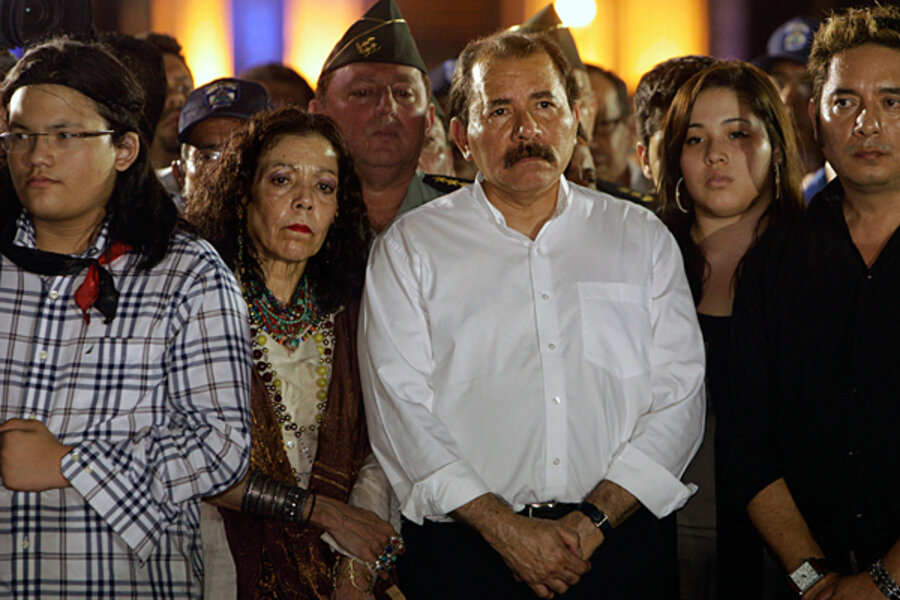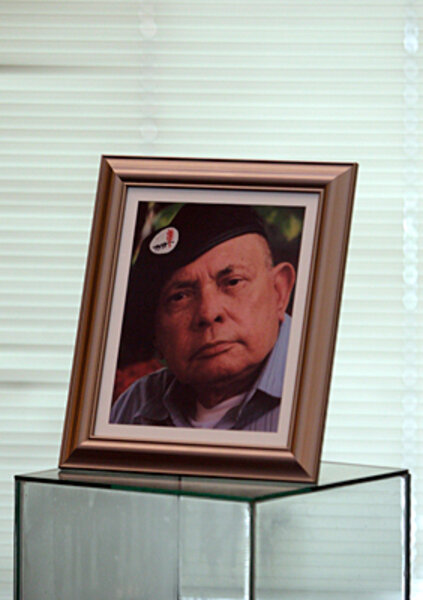Nicaragua divided over death of revolutionary leader
Loading...
| MANAGUA, Nicaragua
The firebrand revolutionary and last living founder of Nicaragua’s Sandinista Front for National Liberation (FSLN), Comandante Tomás Borge, died this week, reopening old divisions from the tumultuous decade of revolutionary rule and counterrevolutionary war in the 1980s.
To his supporters, Mr. Borge was a stalwart revolutionary who fought bravely and endured months of imprisonment and torture to help overthrow the US-backed Somoza dictatorship in 1979. He was both loved and feared by many Nicaraguans for his role in the insurrection in the 1970s and in the subsequent revolutionary government of the '80s, when he served as the iron-fisted minister of the interior dressed in Cuban-made, olive drab military uniforms. Critics claim Borge quickly went from victim to oppressor, repeating the torture and attrocities of the dictatorship he helped overthrew.
The Sandinista Revolution became a cold war proxy and the United States boosted the Contras to fight the FSLN.
As Sandinistas remember Borge’s life, they are calling him a “man of exemplary courage and principle,” “an example for the youth,” a “great revolutionary,” and even “a prophet of God.” Supporters remember him as a sensible and rational man who was both dedicated to the revolution, but humble enough to recognize the mistakes it made in the 1980s.
“We were victims of arrogance,” he told me in 2005, as we sat in his office amid walls covered in photos of Borge posing with a virtual "who’s who" list of US-identified bogymen: Fidel Castro, Col. Muammar Qaddafi, and Yassir Arafat, to name a few. Borge also kept a photograph of Sandinista namesake Gen. Augusto Sandino posing with his father, a revolutionary from the 1930s.
Borge told me the next Sandinista government, which returned to power in 2007, would implement “more realistic” policies and not repeat the mistakes of land confiscations, nationalizations, or mandatory military service. And so far, despite a couple of notable stumbles, the Sandinista government of today has clearly set a different tack than it did in the 1980s.
René Núñez, president of the Sandinista-dominated National Assembly, said Borge was a man who “dedicated his life to the liberty of Nicaragua.”
“He defended Nicaragua; he was Nicaragua,” Núñez said.
Several foreign countries have also paid their respects, including El Salvador, Cuba, Venezuela, Bolivia, Ecuador, and Taiwan. But some in Nicaragua and abroad are remembering Borge for his intolerance, alleged rights abuses, and violent repression of dissidents. Online forums for Nicaragua’s daily newspapers as well as Facebook pages related to Nicaragua reveal a wide range of comments expressing anger and hatred for Borge, and frustration that he was never held accountable for his alleged crimes – including allegations of prisoner torture, an indigenous massacre, and the bombing of a 1984 press conference that killed six people, including American journalist Linda Frazier.
Borge denied involvement in all those cases.
Borge was a complicated man in a complicated country. He was a man with a style all his own; in later years he often dressed in strange “Dr. Evil” outfits that were so unfashionable they were cool. While his loyalty to family was expressed in love, generosity, and kindness – even adopting the son of fallen revolutionary martyr Germán Pomares to raise as his own – his loyalty to the revolution was often displayed as dogmatic intolerance, repression of the opposition, and chilling capacity for violence.
Borge was even controversial within his own party, which has become increasingly appropriated by First Lady Rosario Murillo, who at times seemed to resent Borge’s revolutionary credentials and authentic leadership claims to the party.
When the Sandinistas returned to power democratically in 2007, the first thing Daniel Ortega's administration did was ship Borge off to Peru to be Nicaragua’s Ambassador in Lima, where his wife and children were living. The move kept the outspoken Borge out the Nicaraguan media every day, allowing Murillo to consolidate her policy of government silence and role as propaganda tsar.
Though Borge denied he had problems with Murillo, he played a noticeably less visible role within the party leadership over the past six years, as Murillo’s role became omnipresent. During the 2005 Anniversary of the Sandinista Revolution, Borge was relegated to the second stage designated for special invitees, rather than sitting with the other party leaders on the main stage. He wasn’t present at all at the 2006 anniversary of the Revolution and made minor appearances from then on, as President Ortega and wife dominated the spotlight. And without Borge, the FSLN has the opportunity to revise history without one of the original voices to keep them in check.
For Borge, the revolution’s greatest gift to Nicaragua was hope.
“The revolution recuperated the dignity of the country and achieved some social advancement,” Borge told me once. “The revolution was a seed without which there would be no possibility to produce fruits and flowers. But the fundamental achievement of the revolution was to give birth to hope.”
– A version of this article appeared on the author’s blog, www.nicaraguadispatch.com








